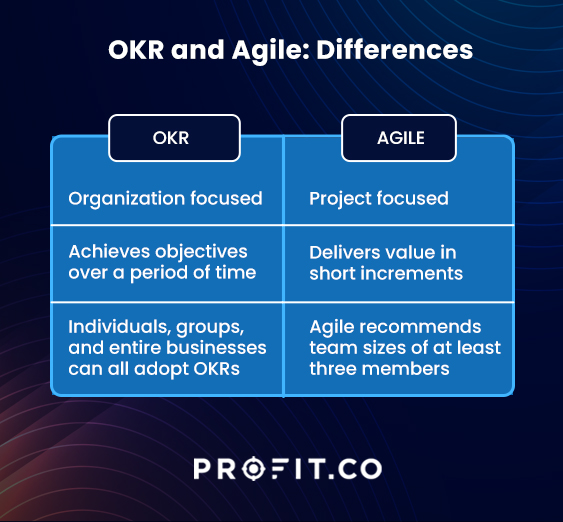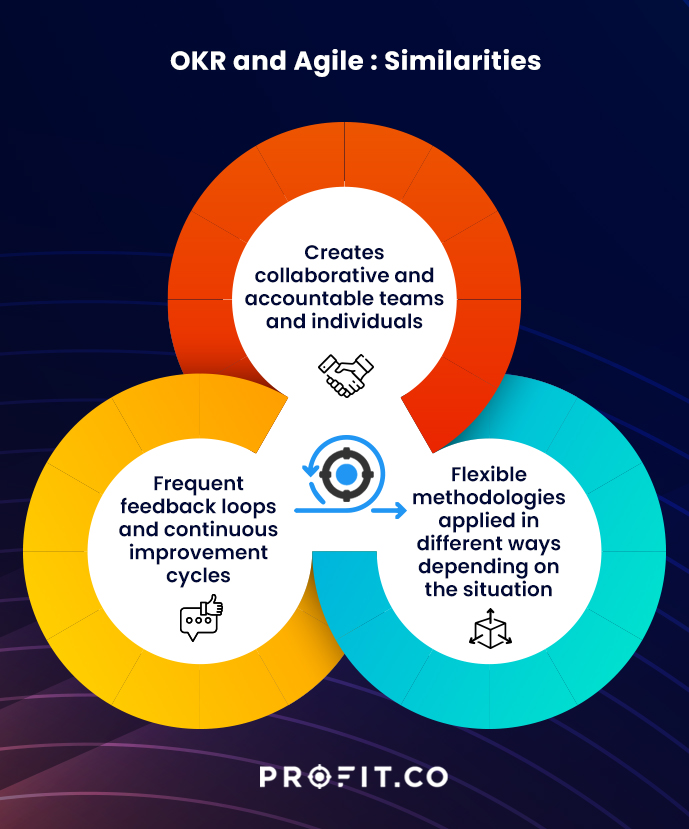Organizations often adopt either OKRs or Agile methodology to achieve their goals. However, using them in combination can yield even better results. When OKR and Agile are used together, it can result in a streamlined, purpose-driven, and practical approach to achieving goals.
OKRs is a methodology for setting ambitious goals that are time-bound and measurable in organizations. Objectives describe what needs to be accomplished, while key results measure progress toward those objectives.
Initially developed for software development, the Agile methodology is widely used across different industries for project management. Agile emphasizes a collaborative and iterative approach. Agile prioritizes value-added activities, resulting in swift improvements, updates, and fixes.
OKR (Objectives and Key Results) is a framework that leverages the motivating power of goals to improve collaboration and productivity. Integrating Agile OKR goals into your daily workflow can enhance your team’s performance.
Integrating OKRs with Agile can strengthen the Agile process and improve agile project management by emphasizing the “how” of each sprint, encouraging collaborative decision-making, and ensuring accountability by linking the backlog to a specific end goal.
Ready to start your OKR journey for Free?
This article will guide you through using Agile OKR effectively.
So, what is Agile, and how does it enable software development?
The Agile methodology comprises software development methods emphasizing flexibility, collaboration, and rapid feedback. Developers and other stakeholders work together in small teams, called scrum teams or squads.
These teams are self-organizing and cross-functional. Meaning they combine all the skills needed to complete a project. The team members collaborate on a common goal or objective.
Agile methods create an environment where teams can do the right work at the right time. They enable organizations to deliver value faster and better adapt to changes in business needs. Agile also helps teams produce higher-quality software because they can respond when problems arise, or new requirements arise.
The term “Agile” gained popularity with the publication of its manifesto in 2001. They outlined its values:
- People and relationships are more important than processes and tools.
- The key to success is building working software, not writing comprehensive documentation.
- Negotiating contracts is an integral part of business, but collaboration between customers and companies often leads to better results.
- Embracing change over sticking to a plan
And its manifestos included the following:
- Delivering software early and often to customers is an essential part of winning them over.
- Be ready for changes throughout the development process even in later phases.
- Work iteratively, prioritizing rapid delivery of working software.
- Businesspeople and developers work together daily during the project.
- Team up with motivated and reliable people.
- When it comes to communicating, nothing beats face-to-face conversations.
- The only thing that counts as progress is working software.
- Sponsors, developers, and users should work together to create a steady stream of releases.
- Technical excellence and good design are paramount to the success of our business.
- The less work you do, the more likely it is that your project will not succeed.
- Diversity and independence are important to ensure that the best architectures, requirements, and designs emerge.
- The team regularly assesses its actions to see whether they are producing the desired results, then makes adjustments accordingly.
OKR and Agile: Differences and similarities
Differences
- The focus of Agile is the project, while the focus of OKR is the organization.
- Agile is focused on delivering value in short increments, while OKR focuses on achieving objectives over a longer period.
- The Agile process is flexible and goal-oriented, while OKRs focus on measurable results.
- Individuals, groups, and entire businesses can all adopt OKRs. Agile recommends team sizes of at least three members for its projects.

Similarities
- Both require collaboration between many people, each with their responsibilities for achieving the common goal(s).
- Both OKRs and Agile involve frequent feedback loops and continuous improvement cycles.
- In both cases, it’s important to set clear expectations for everyone involved in the project, including timelines, budgeting, and quality standards.
- Agile and OKR are both flexible methodologies, meaning that the process can be applied differently depending on the situation.

Making Agile work better with OKR goal setting
You need to do the following:
- Creations of Agile OKRs
The best way to create Agile OKRs is by starting with the existing business goals and then aligning them with your Agile team. You must clearly understand the business goals to set up an Agile process supporting them.
- Consider integrating OKRs into your Agile workflow
Next, it’s time to integrate your Agile OKRs into your daily routine. This can be done by creating a weekly review session where you look at how well you are doing against each goal and course-correct accordingly.
- Utilize OKR tools to manage day-to-day operations
Traditionally, managers have used spreadsheets or other Excel-based tools to track their progress against quarterly OKRs. Use the appropriate tool at the end of this post! This allows you to quickly create visual roadmaps that show how each objective is progressing.
Success today requires the agility and drive to constantly rethink, reinvigorate, react, and reinvent.
FAQs
- What is OKR in Agile?
OKR stands for Objectives and Key Results. It is a goal management system that helps you define, measure, and communicate the results that matter most to the organization. OKRs align teams around mission-critical objectives and create accountability at all levels.
- What is the Agile manifesto?
The Agile manifesto is a set of principles for Agile software development. The manifesto was written by seventeen people who gathered together for the first time in February 2001 to define a common philosophy about Agility.
Conclusion
OKRs are a great way to make Agile work better. The two can be used together in achieving Agile strategy implementation by setting clear, measurable, and ambitious goals and working collaboratively to iterate and adapt to changing circumstances. This can be achieved with the right software to set goals, track progress, and keep your team on track. Profit.co has created a platform that makes it easy to set clear goals and create an open environment where everyone feels like they can contribute. Profit.co’s OKR software also tracks your progress toward goals in real-time. So you can make adjustments as needed without losing steam or momentum.
Experience the power of OKR with Profit.co
Related Articles
-
15 Toughest questions on OKRs Answers by Ben Lamorte – Series 3
We recently hosted an insightful webinar with Ben Lamorte, a leader in OKR coaching. During the session, we covered everything... Read more
-
10 Toughest Questions on OKRs answers by Ben Lamorte -Series 1
In his Mastering OKRs Webinar, Ben Lamorte walks us through his 3-step Formula for successful OKR implementation. He tackles the... Read more
-
14 Toughest Questions on OKRs answers by Ben Lamorte -Series 2
Welcome back to Series 2 of "14 Toughest Questions on OKRs" with Ben Lamorte, where we address the most pressing... Read more
-
OKR Superpower: Aligning Product and Engineering for Maximum Impact
Product and engineering teams often face a tug-of-war between rapid feature delivery and technical feasibility. Product managers want to move... Read more

